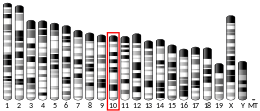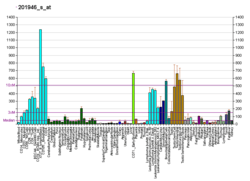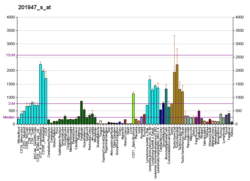CCT2 (gene)
T-complex protein 1 subunit beta is a protein that in humans is encoded by the CCT2 gene.[5][6]
Function
This gene encodes a molecular chaperone that is member of the TRiC complex. This complex consists of two identical stacked rings, each containing eight different proteins. Unfolded polypeptides enter the central cavity of the complex and are folded in an ATP-dependent manner. The complex folds various proteins, including actin and tubulin. Alternate transcriptional splice variants of the gene described in this record have been observed but have not been thoroughly characterized.[6]
Interactions
CCT2 (gene) has been shown to interact with PPP4C.[7][8]
gollark: How is the installer script messing with anyone?
gollark: Not really, why?
gollark: Not in a way potatOS will accept.
gollark: As a sample, I have this virtual omnidisk: https://pastebin.com/9DV5d4Yv
gollark: <@!369987447276437523> PotatOS now lets you run cryptographically signed code disk stuff without the disk!
References
- GRCh38: Ensembl release 89: ENSG00000166226 - Ensembl, May 2017
- GRCm38: Ensembl release 89: ENSMUSG00000034024 - Ensembl, May 2017
- "Human PubMed Reference:". National Center for Biotechnology Information, U.S. National Library of Medicine.
- "Mouse PubMed Reference:". National Center for Biotechnology Information, U.S. National Library of Medicine.
- Won KA, Schumacher RJ, Farr GW, Horwich AL, Reed SI (Dec 1998). "Maturation of human cyclin E requires the function of eukaryotic chaperonin CCT". Molecular and Cellular Biology. 18 (12): 7584–9. doi:10.1128/mcb.18.12.7584. PMC 109339. PMID 9819444.
- "Entrez Gene: CCT2 chaperonin containing TCP1, subunit 2 (beta)".
- Chen GI, Tisayakorn S, Jorgensen C, D'Ambrosio LM, Goudreault M, Gingras AC (Oct 2008). "PP4R4/KIAA1622 forms a novel stable cytosolic complex with phosphoprotein phosphatase 4". The Journal of Biological Chemistry. 283 (43): 29273–84. doi:10.1074/jbc.M803443200. PMC 2662017. PMID 18715871.
- Gingras AC, Caballero M, Zarske M, Sanchez A, Hazbun TR, Fields S, Sonenberg N, Hafen E, Raught B, Aebersold R (Nov 2005). "A novel, evolutionarily conserved protein phosphatase complex involved in cisplatin sensitivity". Molecular & Cellular Proteomics. 4 (11): 1725–40. doi:10.1074/mcp.M500231-MCP200. PMID 16085932.
External links
Further reading
- Kubota H, Hynes G, Carne A, Ashworth A, Willison K (Feb 1994). "Identification of six Tcp-1-related genes encoding divergent subunits of the TCP-1-containing chaperonin". Current Biology. 4 (2): 89–99. doi:10.1016/S0960-9822(94)00024-2. PMID 7953530.
- Llorca O, Smyth MG, Carrascosa JL, Willison KR, Radermacher M, Steinbacher S, Valpuesta JM (Jul 1999). "3D reconstruction of the ATP-bound form of CCT reveals the asymmetric folding conformation of a type II chaperonin". Nature Structural Biology. 6 (7): 639–42. doi:10.1038/10689. PMID 10404219.
- Hynes GM, Willison KR (Jun 2000). "Individual subunits of the eukaryotic cytosolic chaperonin mediate interactions with binding sites located on subdomains of beta-actin". The Journal of Biological Chemistry. 275 (25): 18985–94. doi:10.1074/jbc.M910297199. PMID 10748209.
- Yokota S, Yanagi H, Yura T, Kubota H (Sep 2001). "Cytosolic chaperonin-containing t-complex polypeptide 1 changes the content of a particular subunit species concomitant with substrate binding and folding activities during the cell cycle". European Journal of Biochemistry / FEBS. 268 (17): 4664–73. doi:10.1046/j.1432-1327.2001.02393.x. PMID 11532003.
- McCormack EA, Llorca O, Carrascosa JL, Valpuesta JM, Willison KR (Aug 2001). "Point mutations in a hinge linking the small and large domains of beta-actin result in trapped folding intermediates bound to cytosolic chaperonin CCT". Journal of Structural Biology. 135 (2): 198–204. doi:10.1006/jsbi.2001.4385. PMID 11580269.
- Gevaert K, Goethals M, Martens L, Van Damme J, Staes A, Thomas GR, Vandekerckhove J (May 2003). "Exploring proteomes and analyzing protein processing by mass spectrometric identification of sorted N-terminal peptides". Nature Biotechnology. 21 (5): 566–9. doi:10.1038/nbt810. PMID 12665801.
- Imai Y, Soda M, Murakami T, Shoji M, Abe K, Takahashi R (Dec 2003). "A product of the human gene adjacent to parkin is a component of Lewy bodies and suppresses Pael receptor-induced cell death". The Journal of Biological Chemistry. 278 (51): 51901–10. doi:10.1074/jbc.M309655200. PMID 14532270.
- Jin J, Smith FD, Stark C, Wells CD, Fawcett JP, Kulkarni S, Metalnikov P, O'Donnell P, Taylor P, Taylor L, Zougman A, Woodgett JR, Langeberg LK, Scott JD, Pawson T (Aug 2004). "Proteomic, functional, and domain-based analysis of in vivo 14-3-3 binding proteins involved in cytoskeletal regulation and cellular organization". Current Biology. 14 (16): 1436–50. doi:10.1016/j.cub.2004.07.051. PMID 15324660.
- Andersen JS, Lam YW, Leung AK, Ong SE, Lyon CE, Lamond AI, Mann M (Jan 2005). "Nucleolar proteome dynamics". Nature. 433 (7021): 77–83. doi:10.1038/nature03207. PMID 15635413.
- Guo D, Han J, Adam BL, Colburn NH, Wang MH, Dong Z, Eizirik DL, She JX, Wang CY (Dec 2005). "Proteomic analysis of SUMO4 substrates in HEK293 cells under serum starvation-induced stress". Biochemical and Biophysical Research Communications. 337 (4): 1308–18. doi:10.1016/j.bbrc.2005.09.191. PMID 16236267.
This article is issued from Wikipedia. The text is licensed under Creative Commons - Attribution - Sharealike. Additional terms may apply for the media files.





